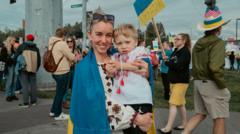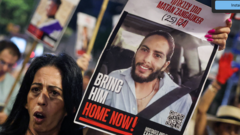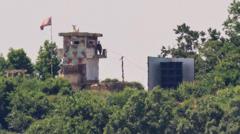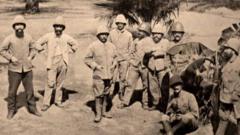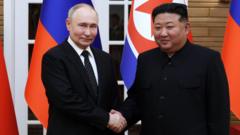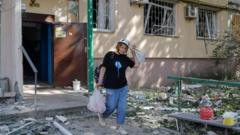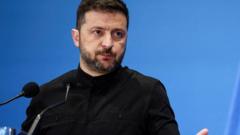Ukrainian residents of the Russian-occupied city of Mariupol are speaking out against the false narratives propagated by Russia. Despite claims of recovery, reports from locals paint a picture of destruction, scarce resources, and educational propaganda aimed at children. Resistance against occupying forces continues, with brave Ukrainians documenting military movements while living in constant fear.
Unveiling the Truth: Mariupol Residents Counter Russian Narratives
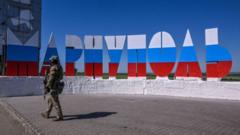
Unveiling the Truth: Mariupol Residents Counter Russian Narratives
As Russian authorities paint a rosy picture of life in Mariupol, locals reveal the grim realities of continued suffering and state propaganda.
In the heart of Mariupol, a stark disparity exists between the images depicted in Russian media and the daily lives of its residents. "What they're showing on Russian TV are fairy tales for fools. Most of Mariupol still lies in ruins," says John, a local who remains anonymous due to fears of reprisal. According to him, the areas featured in state broadcasts are merely superficial repairs while much of the city is in shambles.
Three years have passed since Mariupol fell to Russian forces following a devastating siege that claimed countless lives and left around 90% of buildings in disrepair, as estimated by the UN. Recent pro-Russian content has attempted to present an illusion of normalcy, but residents tell a very different story.
Olha Onyshko, who escaped the brutal conditions last year, asserts that only certain central areas have been addressed, leaving a patchwork of destruction elsewhere. "They cleared the debris, but didn't even separate out the dead bodies," she reveals, painting a horrific picture of the aftermath.
Water shortages have compounded the city's struggles, with residents experiencing erratic supply and poor quality. James, another Mariupol local, describes the water as dangerously unclean. "We keep buckets and cans of water at home. The colour is so yellow that even after boiling it, it's scary to drink," he says. The remaining water sources have dwindled due to ongoing conflict, with some areas now devoid of safe drinking water.
The economic reality is dire, characterized by frequent power outages, skyrocketing food prices, and a lack of medical resources. Insulin is notably hard to come by, leaving diabetics vulnerable. The dire circumstances reflect the brutal reality that the Russian administration has not addressed.
Perhaps most disturbing is the influence on education, with children being exposed to state propaganda. Andrii Kozhushyna, who attended school under occupation, recounts how students are taught that various regions now belong to Russia, alongside lessons glorifying military actions.
While Russian flags and cultural symbols flood the streets during propaganda events, many Ukrainians resist in secrecy. Using the cover of night, they spread messages of hope and resistance, defying the narrative imposed by occupying forces. James and John, members of underground resistance groups, continue to document military movements and gather intelligence for the Ukrainian military while living under constant threat of exposure.
For them, each day is marked by risk and uncertainty. "You're afraid to call friends in Ukraine in case your phone is being tapped," reveals James, summarizing the ever-present tension of navigating life in an occupied city.
As discussions for peace emerge, many residents firmly believe relinquishing land would betray the sacrifices they've made for their freedom. "We want liberation," emphasizes John, echoing the sentiments of those unwilling to accept a 'peace at any cost.' The stories from Mariupol are more than just accounts of hardship — they’re reminders of the resilience and unyielding spirit of those who continue to fight for their homeland.


